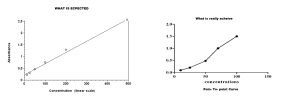No products in the cart.
ELISA Performance tests
ELISA Minimum Detection Limit
What is the ELISA Minimum Detection Limit in ELISA kits?
The ELISA Minimum Detection Limit or Lower limit of quantification (LLOQ) for ELISA test is the lowest concentration level of analyte that can be determined by statistically different from the Zero concentration ELISA standard or blank at a 99% confidence level in ELISA standard curve.
Sometimes The Minimum Detection Limit or Lower limit of quantification (LLOQ) is referred to minimum concentration of analyte that can be added to ELISA Zero Standard or ELISA Black and is recovered by ELISA test by statistically different. In this case, Matrix Effect is the most important factor for The Minimum Detection Limit.
ELISA Upper Detection Limit
The ELISA Upper Detection Limit or upper limit of quantification (ULOQ) for ELISA test is the upper concentration level of analyte that can be determined statistically differently by ELISA at a 99% confidence level. It is practically the amount of analyte that can be determined statistically than highest ELISA standard in ELISA standard curve.ELISA Test Precision (ELISA Intra-assay and Inter-assay CV)
ELISA test precision is divided into Intra-assay and Inter-assay coefficient of variability (CV).
Intra-assay coefficient of variability (CV) is a measure of the variance between data points within a single plate and single assay. It reflects the CV between 10 or more tests that are performed in a one test with one person.
Inter-assay coefficient of variability (CV) is a measure of the variance between data points between several runs of an ELISA test that can be done in different time by different personnel on a single sample.
In ELISA Intra-assay test, the number of test repetition should not be less than 10 and in Inter-assay the number of tests is generally more. Acceptable %CV in ELISA Intra-assay test is less than 10 and in ELISA Intre-assay test %CV is less than 15.
ELISA Test Specificity
The ability of ELISA test to determine the analyte that test is designed for, is called specificity. Normally False positive reactions may decrease ELISA specificity test. Factors that affect the specificity of test are Coating purity, Conjugated Antibody nature, Analyte Cross-Reactions, Interference, Non-specific binding, and plate overall background. Poly-clonal Antibodies may result in less ELISA test specificity while generally Monoclonal antibodies provide more specific ELISA tests.
ELISA Sensitivity
ELISA Sensitivity is the lowest value of analyte in sample where the assay can statistically differentiate from background. It is directly related to affinity of antibodies, Matrix effect, Non-specific binding capacity of ELISA reagents and incubation time. The more sensitive ELISA tests usually have less ELISA Minimum Detection Limit and more linear ELISA standard curve.
ELISA Spike and Recovery Test
In ELISA Spike/Recovery test, a known amount of analyte is “spiked” into a sample and run in ELISA test together with original sample. The resulting concentration, or “recovery” of the spiked material compared to original sample concentration is evaluated. Sometimes two samples mixed and is tested and analysis for recovery. Factors like Matrix Effect, salt concentration, Buffer nature, and sample diluent can affect the ELISA Spike/Recovery test.
ELISA linearity test
A measure of parallelism between the dilution of the standard protein and native signal. If both the standard protein and native signal dilute proportionally, interpolated sample values will have an identical value at all doses tested once corrected for dilution. Linearity of dilution experiments are used to determine what concentrations of a given biological matrix are compatible with the assay and define the linear range of the assay for that biological sample.
Linearity of dilution is determined by measuring multiple dilutions of known positive samples by ELISA. The concentration of the target protein is determined by multiplying the dilution factor by the calculated concentration.

Linear ELISA curve VS point to point curve
Matrix effects
The combined effect of all components in the sample, other than the analyte, on the measurement of the specific analyte. In fact, Interactions between target analyte of interest and other components in the sample, and their reaction with Conjugate stabilizer or sample diluent components is called matrix effects.
Factors like Sample diluent buffer, Conjugate stabilizer buffer, Assay buffer, PH of the sample and ELISA reagents, High viscosity, direct interaction between the analyte of interest and other proteins and components in the sample, and Salt concentration can affect the Matrix Effect in ELISA.
How to determine if you have adverse ELISA Matrix effect?
To determine if ELISA kit has a matrix problem, you need to perform an ELISA Spike and Recovery test. ELISA Recovery test results must be close to 100%, but recovery between 90 to 110% is perfect.
Serial dilution and ELISA linearity test are also other measurements for Matrix effect. A more linear Elisa test shows better matrix in ELISA tests.
International units in ELISA tests
International units (IU) in Immunoassy standards are assigned to reference materials to allow the assessment of ‘biologicals’ in a consistent internationally agreed manner when the physico-chemical determination of the standard units such as exact weight, volume, Molarity and MW is not possible.



